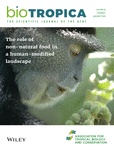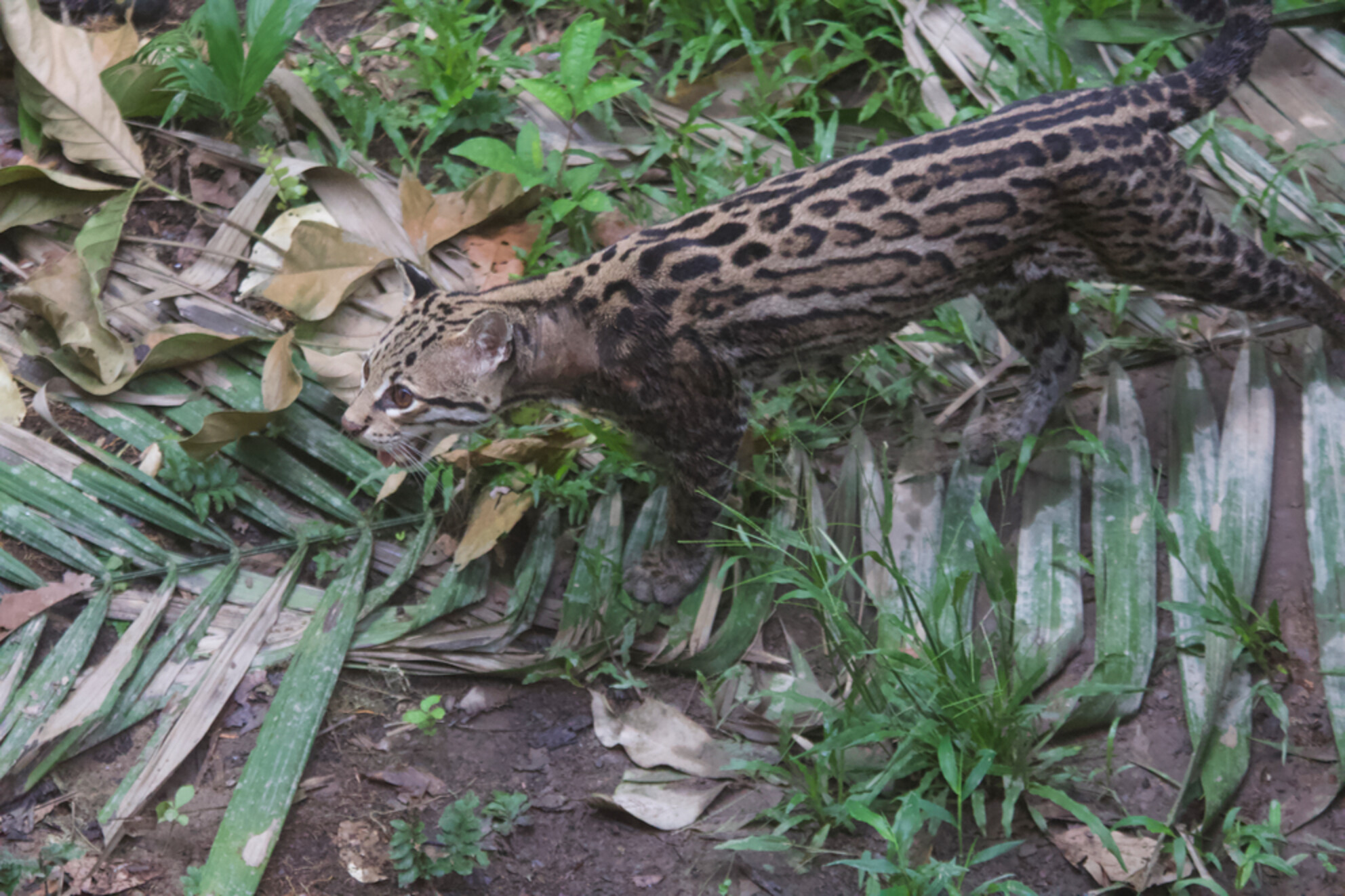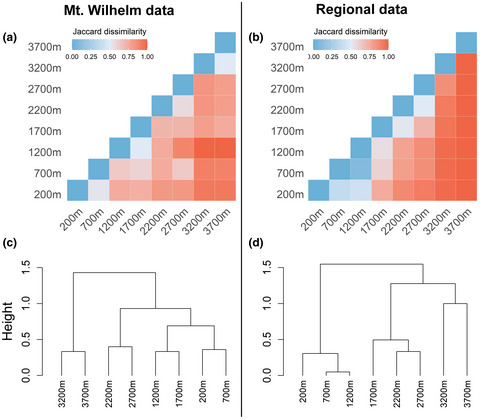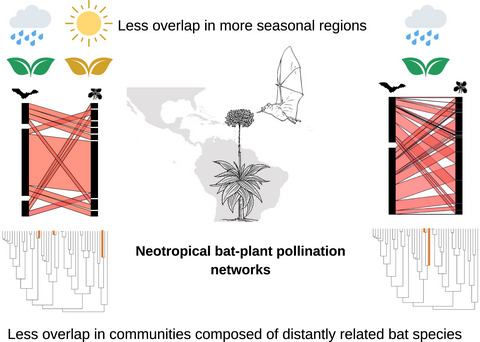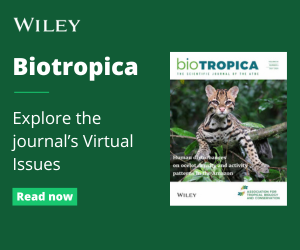Journal list menu
Export Citations
Download PDFs
ISSUE INFORMATION
COMMENTARY
Recolonization of secondary forests by locally extinct fauna through the lens of range expansion: Four open questions
- Pages: 1-6
- First Published: 03 December 2022
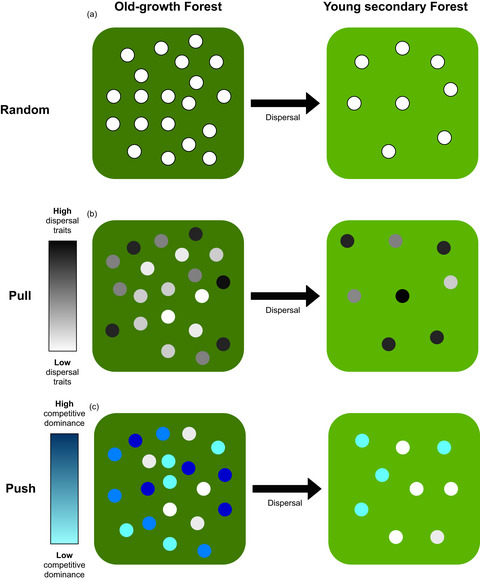
Recolonization of secondary forests happens when individuals disperse from a nearby source old-growth forest populations. This pattern of recolonization could be (a) the result of a random subset of individuals dispersing and colonizing nearby secondary habitats. Instead, the set of recolonizing individuals may not be random but have a particular set of characteristics. (b) Old-growth source populations could show spatial sorting where highly dispersive individuals (those with larger limbs, or exploratory and aggressive behavior) are overrepresented in the forest patch edges and more likely to colonize nearby patches. These are often known as “pull” expansions because highly dispersive individuals living at the edge of the source population are the ones “pulling” the expansion. Alternatively, (c) because old-growth populations are expected to be at carrying capacity recolonization may be driven by subordinate individuals that cannot outcompete dominant conspecifics and disperse looking for alternative territories. This is the case of “push” expansions when dispersal is driven by these subordinate individuals that are pushed away due to density dependence.
INSIGHTS
Radiocarbon estimates of age and growth for a dominant Amazon palm species
- Pages: 7-12
- First Published: 20 September 2022
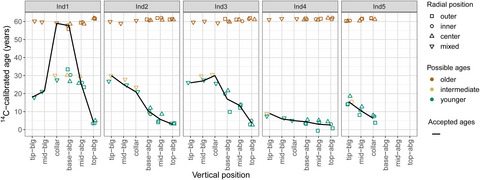
We used destructive sampling to assess 14C-calibrated age and growth of five individuals of Oenocarpus bataua Mart. (ARECACEAE) from 7.35-21.6 m of total height. The largest individual was 59-years old. Age decreased from the collar to the top of the aboveground stem and was positively correlated with number of leaf-scars and height.
The empty forest three decades later: Lessons and prospects
- Pages: 13-18
- First Published: 08 December 2022

The “Empty Forest” paradigm published three decades ago inspired several studies on biodiversity erosion that cast new light on the consequences of biodiversity loss. This calls for a more proactive approach by several societal actors to realign systems of resource exploitation with the goals of the Convention on Biological Diversity, which was conceived during the Rio Summit in the same year of Redford's “empty forest” paper. Despite significant advances in documenting the causes and consequences of defaunation, wildlife population declines have been hardly curbed or reversed due to many persisting socio-political roadblocks that are yet to be addressed.
NATURAL HISTORY FIELD NOTES
Reproductive niche differentiation in syntopic tropical tree frogs (Agalychnis)
- Pages: 19-23
- First Published: 14 October 2022
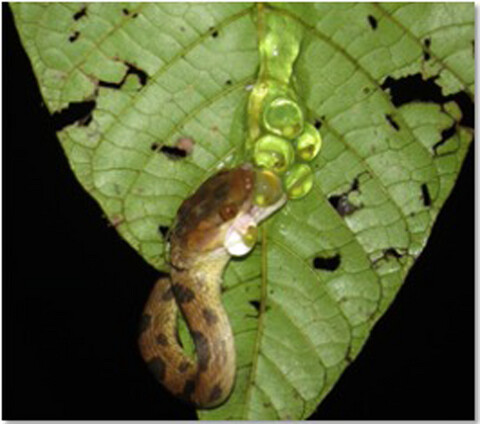
Small differences in syntopic Agalychnis callidryas and A. spurrelli oviposition sites and embryo predation via snakes and invertebrates provide context for previously unexplainable differences in the embryonic behavioral risk responses. Correlations in reproductive and ecological traits suggest character displacement in the syntopic populations of these species.
An unprecedented and unprovoked attack by a free-ranging ocelot (Leopardus pardalis) in the Peruvian Amazon
- Pages: 24-28
- First Published: 23 November 2022
REVIEW
Ant diversity decreases during the dry season: A meta-analysis of the effects of seasonality on ant richness and abundance
- Pages: 29-39
- First Published: 03 October 2022
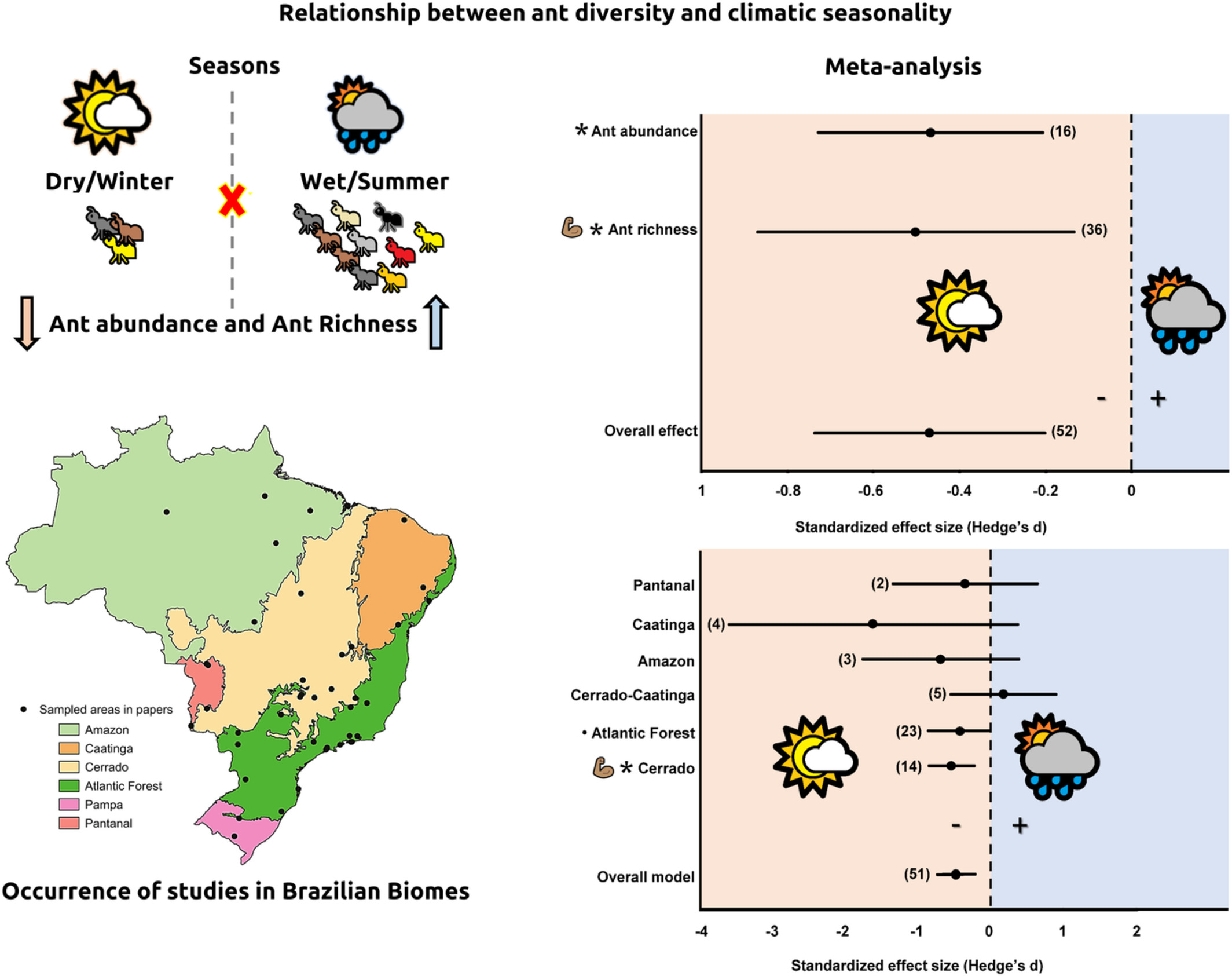
This study addressed the relationship between ant diversity and climatic seasonality, performing a quantitative review of the published data on ant diversity collected in Brazil. Our meta-analysis reveals that the ant diversity globally decreases in the dry season, strongly in the Cerrado biome. Additionally, we point out differences in the sampling effort across biomes, indicating the need for further investments in studies focused on temporal diversity patterns, including seasonal effects, on the insect assemblage in biomes less investigated so far.
ORIGINAL ARTICLES
The legacy of forest logging on organic matter inputs and storage in tropical streams
- Pages: 40-52
- First Published: 22 September 2022
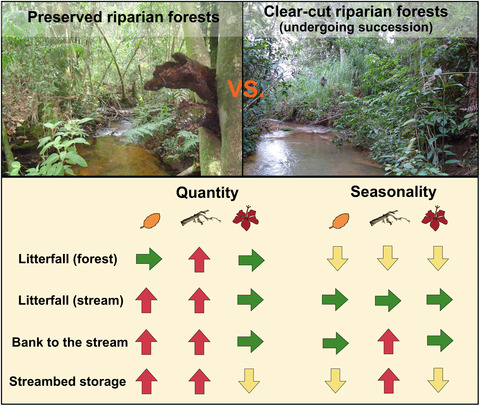
Forest harvesting is a widespread disturbance that significantly reduces forest cover and impairs freshwaters. However, the legacy of forest clear-cut logging on key processes is mostly unknown to the tropics. Here we show that clear-cut logging has a legacy impact on litter subsidies to riparian ecosystems – shifting the type, quantity and seasonality of litter – even if residual woody vegetation is maintained in riparian buffers.
Climate change induced elevational range shifts of Himalayan tree species
- Pages: 53-69
- First Published: 27 September 2022
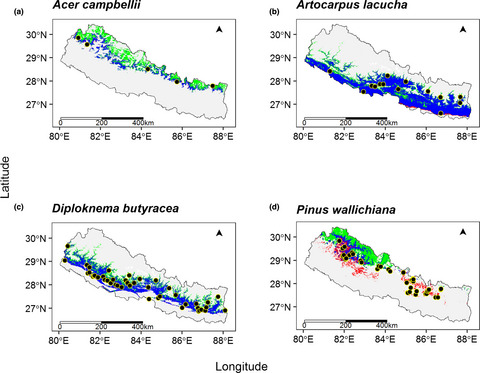
The predicted average upslope shift in maximum elevation (8 m/year) is >2 times faster than the current observations indicating that many species will not be able to track climate change and potentially go extinct, unless they are supported by active conservation measures, such as assisted migration.
Trophic cascades in tropical rainforests: Effects of vertebrate predator exclusion on arthropods and plants in Papua New Guinea
- Pages: 70-80
- First Published: 30 September 2022
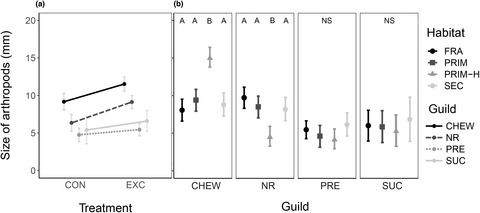
Insect herbivores have the potential to consume large amounts of plant tissue in tropical forests, but insectivorous vertebrates effectively control their abundances, indirectly increasing plant fitness accordingly. In a three-month long predator exclosure experiment we found that vertebrate predators reduced arthropod density by ∼52%, decreased the mean body size of arthropods by 26% in leaf chewers and 47% in non-herbivorous arthropods but had only a small effect on mesopredators and sap suckers, which resulted in a ~ 41% increase in leaf damage. Our results, across different types of tropical forests in Papua New Guinea, demonstrate that flying vertebrate insectivores have a crucial impact on plant biomass, create a selective pressure on larger and non-predatory prey individuals and they prey partition with mesopredators.
Species richness and assemblages of bats along a forest elevational transect in Papua New Guinea
- Pages: 81-94
- First Published: 02 October 2022
Genetic inference of orchid population dynamics on different-aged lava flows in Costa Rica
- Pages: 95-105
- First Published: 20 October 2022
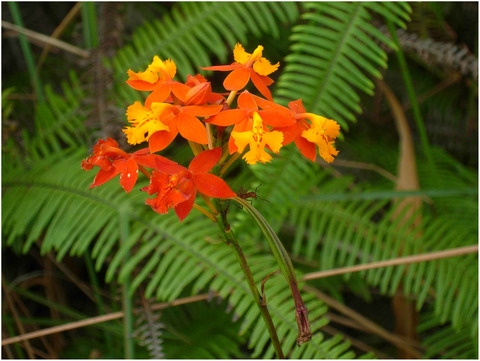
Volcán Arenal lava flows represent natural, non-anthropogenic habitat disturbance that permit precise knowledge of when these sites became available for colonization. By examining the levels and spatial distribution of genetic variation of five Epidendrum radicans populations growing on lava flows deposited in 1968 and 1992, we were able to infer patterns of colonization and population expansion processes.
The role of non-natural foods in the nutritional strategies of monkeys in a human-modified mosaic landscape
- Pages: 106-118
- First Published: 22 October 2022
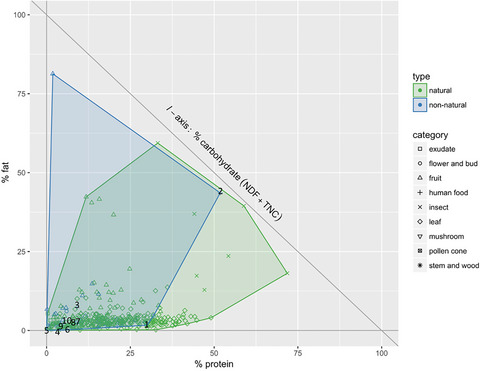
Wildlife in human-altered mosaic habitats may eat non-natural foods, but little is known about the nutritional implications of such behavior. This study documents how forest-dwelling monkeys consume a third of their calories from non-natural foods (mainly exotic plants), yet are able to achieve a similar nutrient balance regardless of exposure to and intake of these foods. Forest and forest-adjacent areas with non-natural vegetation may extend or enrich suitable habitat in terms of nutrient access for consumers, and thus contribute to wildlife conservation.
Rainforest conversion to smallholder cash crops leads to varying declines of beetles (Coleoptera) on Sumatra
- Pages: 119-131
- First Published: 14 October 2022

This study compared canopy beetle density and diversity between lowland rainforest and the three main cash crop agriculture systems in Sumatra, Indonesia: jungle rubber agroforest, and monoculture plantations of rubber and oil palm. Focusing on the four beetle families Chrysomelidae, Curculionidae, Elateridae and Staphylinidae, we demonstrate severe population and richness declines, as well as altered community composition and beta diversity patterns after rainforest conversion to cash crop agriculture in Southeast Asia.
Variation of seasonal litterfall in subtropical montane cloud forests to typhoon severity and environmental factors
- Pages: 132-144
- First Published: 20 October 2022
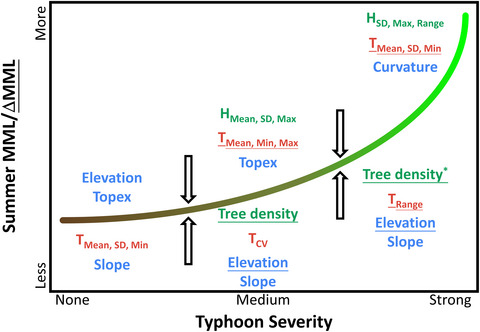
A conceptual model to illustrate the relationship between summer typhoon season litterfall fluxes and typhoon severity (the x-axis), and the biophysical (green text), bioclimatic (red text) and topographic (blue text) factors that positively or negatively influence MML (mean monthly litterfall) or ΔMML (typhoon-induced additional MML, underscored text) (the y-axis). The color gradient of the curve indicates the colors of litterfall from brown senescent to green fresh tissues.
Limited genetic differentiation of Mycetomoellerius mikromelanos in Parque National Soberanía, Panama: Implications for queen dispersal
- Pages: 145-159
- First Published: 09 November 2022
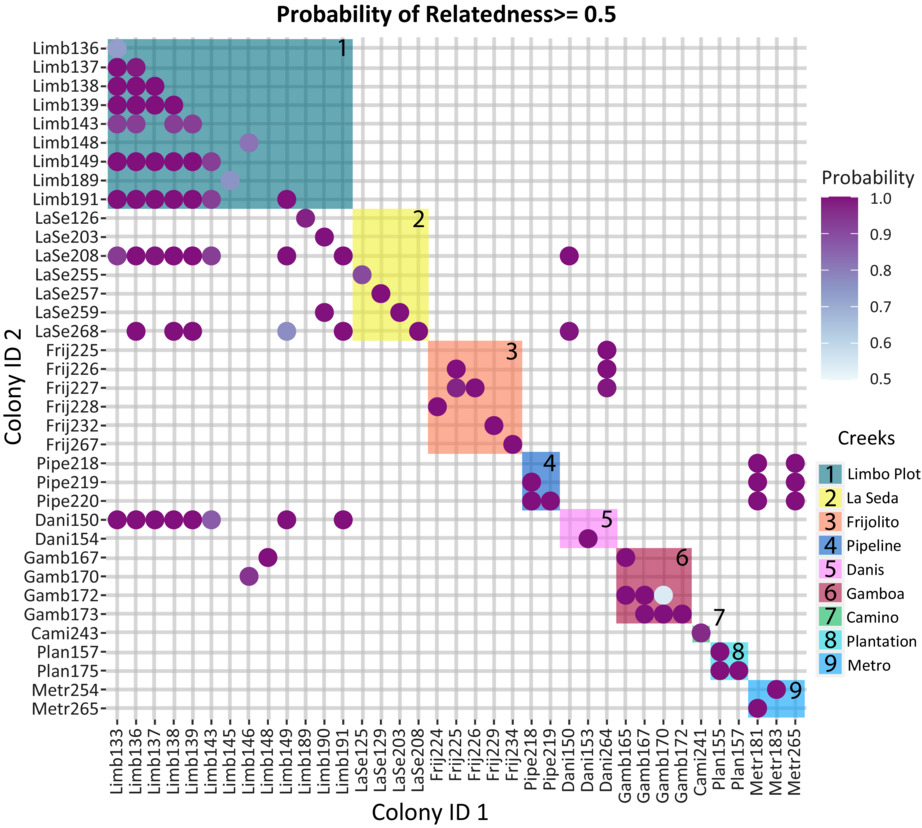
We investigated the population genetics of a new species of fungus-growing ant from Parc National Soberanía in the Panama Canal Zone. Closely related colonies were identified on the same or neighboring creeks, and some closely related colonies on distant creeks. Our results provide insight into the dispersal of Mycetomoellerius mikromelanos in the Panama Canal zone.
Limited seed dispersal shapes fine-scale spatial genetic structure in a Neotropical dioecious large-seeded palm
- Pages: 160-172
- First Published: 21 November 2022
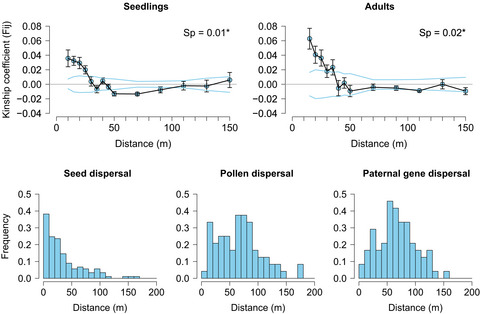
We inferred fine-scale spatial genetic structure (FSGS) and estimated realized dispersal distances in Phytelephas aequatorialis, a Neotropical dioecious large-seeded palm. Our results show that limited seed dispersal mediated by rodents shapes FSGS in P. aequatorialis, while more extensive pollen dispersal accounts for a larger contribution to gene flow and may maintain high genetic diversity. Additionally, pollen dispersal distances depended on the density of male palms, decreasing when individuals show a clumped distribution and increasing when they are scattered.
Aridity and chronic anthropogenic disturbance as organizing forces of fruit-feeding butterfly assemblages in a Caatinga dry forest
- Pages: 173-184
- First Published: 09 November 2022
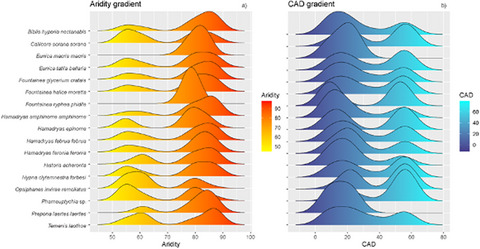
Chronic disturbance and water deficit operate as important drivers of the spatial organization of fruit-feeding butterfly assemblages across human-modified landscapes of the Caatinga dry forest by affecting a large set of community-level attributes. More specifically, we found that abundance, alpha diversity, and species turnover of fruit-feeding butterfly assemblages were all highest in wetter areas. Additionally, the chronic disturbances also have a negative effect on the total number of species (0D) of fruit-feeding butterflies.
Determinants of resource use in lizard assemblages from the semiarid Caatinga, Brazil
- Pages: 185-196
- First Published: 11 November 2022
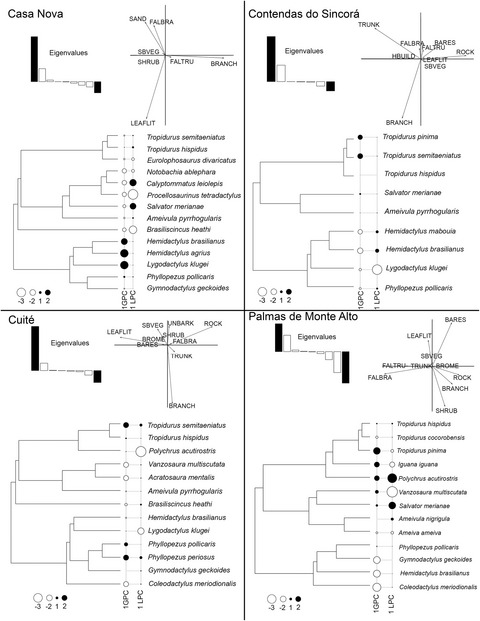
Non-sessile animals could partition the use of resources in different axes, reducing the effects of competition and allowing coexistence. Here, we investigated the spatial and trophic niche dimensions in four lizard assemblages in the Neotropical semiarid Caatinga to investigate the determinants of resource use and the extent which lizards partition their niches.
Long-term fire and vegetation change in northwestern Amazonia
- Pages: 197-209
- First Published: 02 December 2022
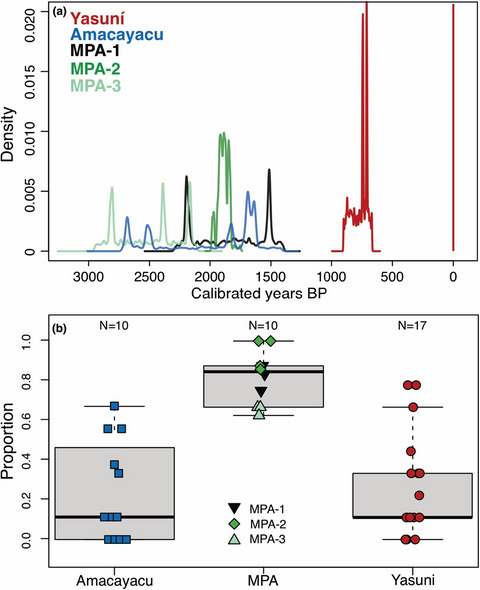
Forest plots in Amazonia are often assumed to be undisturbed, but recent work suggests that past people can affect modern vegetation composition in the form of ecological legacies. We investigated the past fire and vegetation history of the Yasuní Forest Dynamics plot and compared that to other forest plots in northwestern Amazonia. Our data suggest that post-Columbian human disturbances from the Rubber Boom (AD 1850-1920) and subsequent oil exploration have likely left stronger ecological legacies than those left by pre-Columbian peoples in northwestern Amazonia.
Variations in the reproductive cycle of Bornean montane tree species along elevational gradients on ultrabasic and non-ultrabasic soils
- Pages: 210-220
- First Published: 25 November 2022

Using 10-year monitoring data of litterfall from six tropical montane rainforest sites on Mount Kinabalu, Borneo, we revealed that many tree species exhibited supra-annual cycles of reproduction at high elevations (2700 and 3100 m a.s.l.) but annual or sub-annual cycles at lower elevations (1700 m a.s.l.). This elevational pattern was consistent regardless of soil types (i.e. infertile ultrabasic soils versus relatively fertile non-ultrabasic soils).
Factors limiting plant recruitment in a tropical Afromontane Forest
- Pages: 221-231
- First Published: 23 November 2022
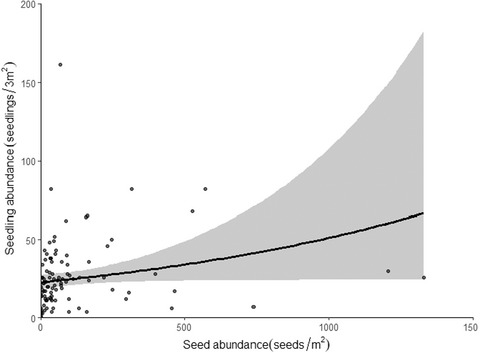
Which species are most likely to successfully recruit depends on a multitude of factors, but with processes operating at the seed-to-seedling transition being especially important. In this study, we explore how insufficient seed dispersal (dispersal limitation) and ecological filtering of seedlings (establishment limitation) influence species recruitment in an Afromontane Forest. Our results suggest that both dispersal and establishment limitation are markedly high in this Afromontane Forest than would be expected in a lowland counterpart.
Impact of human foraging on tree diversity, composition, and abundance in a tropical rainforest
- Pages: 232-245
- First Published: 27 November 2022
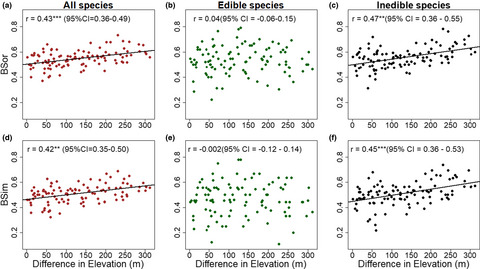
Tropical forest tree communities are structured by a range of large-scale drivers including elevation, certain high-impact anthropogenic activities (e.g., deforestation), and fires. However, low-impact human activities such as foraging may also be altering the composition and distribution of tropical forest trees species. The study assessed the (i) differences in species diversity, patterns of relative abundance, and pairwise beta diversity between trees with edible and inedible fruits and seeds along an elevation gradient, and (ii) impact of human foraging on the forest tree communities in Oban Division of Cross River National Park, Nigeria. The study showed that human foraging of edible fruits may have subtly influenced patterns of species diversity and community structure in this tropical forest.
Evolutionary history and precipitation seasonality shape niche overlap in Neotropical bat–plant pollination networks
- Pages: 246-255
- First Published: 29 November 2022
Fine-scale temporal dynamics of flower visitors sheds light on insect-assemblage overlap between sexes in a dioecious Ecuadorian palm
- Pages: 256-267
- First Published: 08 December 2022
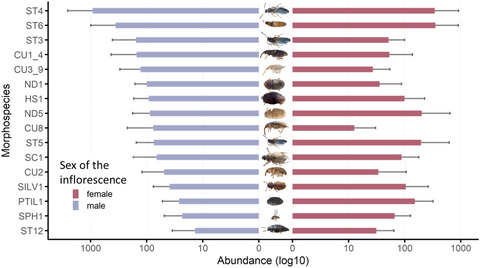
We characterized the composition and the temporal variations of the arthropods community visiting female and male inflorescences of the palm Phytelephas aequatorialis. We report 59 morphospecies dominated by three beetle families: Staphylinidae, Nitidulidae, and Curculionidae and 16 pollinator candidates among which nine visited both inflorescence sexes synchronously at dusk/night.
High diversity and low specificity of fungi associated with seedless epiphytic plants
- Pages: 268-276
- First Published: 25 November 2022
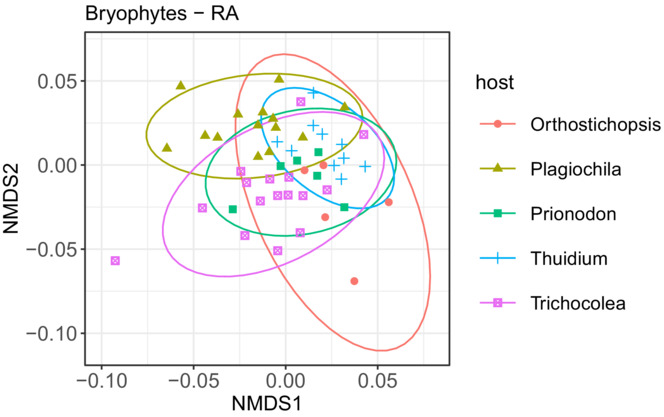
Tropical forests can host a diverse assemblage of epiphytic plants, which in host communities of fungi. We assessed the host- and habitat-specificity of epiphyte-associated fungi, including endophytic fungi. We found small differences in fungal communities among hosts and habitat, suggesting that fungal communities are assembled largely through stochastic processes.
Latitudinal cline of flowering and fruiting phenology in Fagaceae in Asia
- Pages: 277-285
- First Published: 30 November 2022
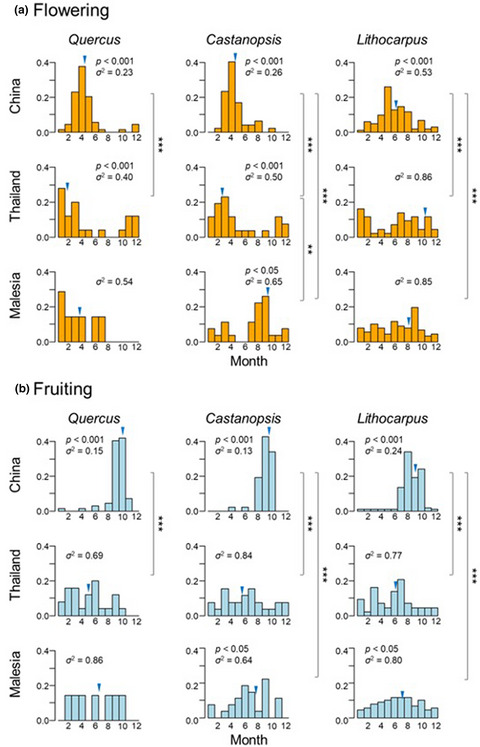
To explore the latitudinal cline in the reproductive phenology of the Fagaceae in Asia, we analyzed phenology data for a total of 94, 121, and 219 species from Thailand, Malesia, and China, respectively, in the three genera of Fagaceae, Quercus, Castanopsis, and Lithocarpus. The flowering period lengthened with decreasing latitude in the animal-pollinated genera Castanopsis and Lithocarpus. The fruiting period lengthened with decreasing latitude in all three genera.




